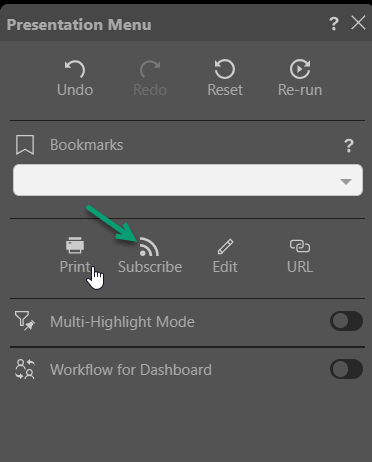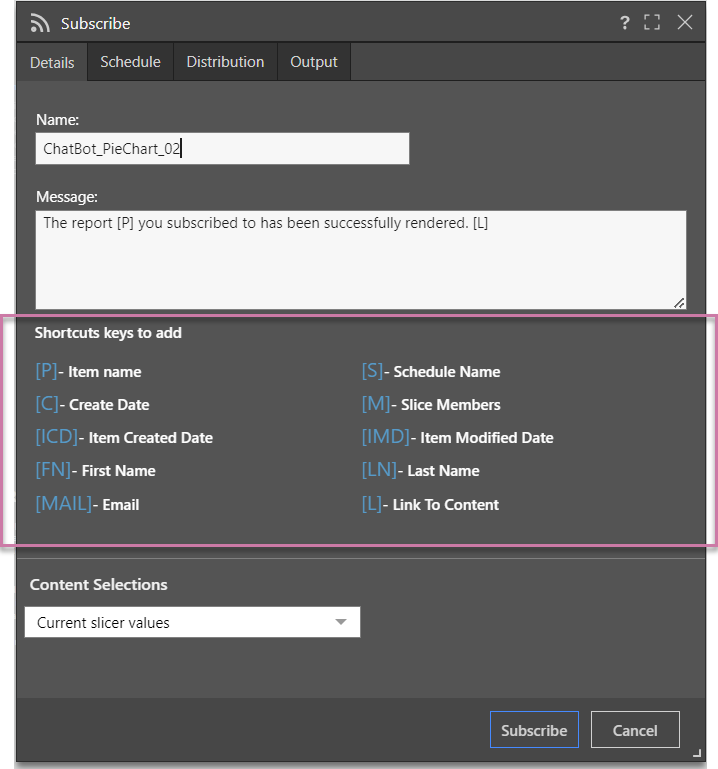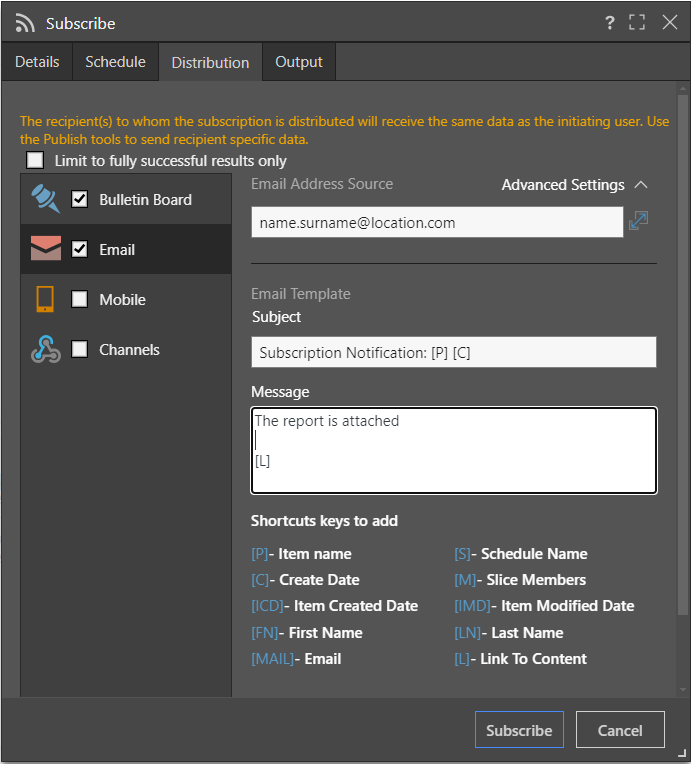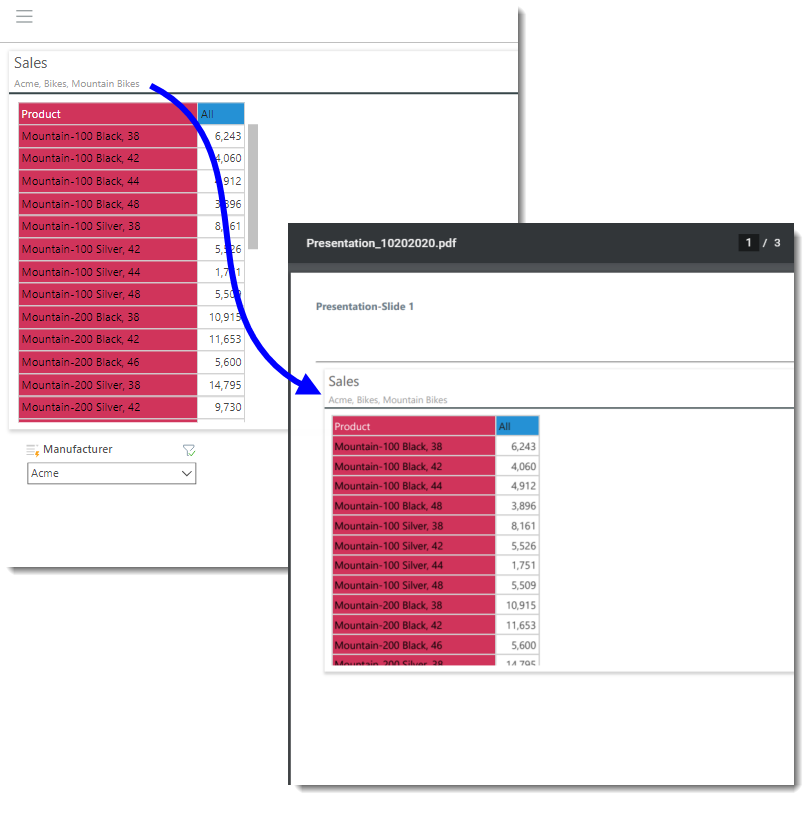You can subscribe to a presentation; setting up a schedule against which your presentation is generated with its current data, details of the message you'd like to receive, and the subscription output / format type. You can also share the presentation with the members of a distribution list according to your specified schedule. For example, you might want to receive a sales presentation containing the latest data on a monthly basis and also distribute that same report to your management team (popping up on their bulletin board).
Subscriptions effectively export or print the content in a selected document format and then provide you with access to that content and distribute it to a distribution list on a scheduled basis.
Note: This feature is available with the Enterprise Edition license only.
Configuring a subscription involves choosing an output, defining the schedule, and setting up distribution using the bulletin board or email. This allows you to share presentations in a similar way to the scheduling and distribution of publications. The setup of subscriptions is similar across the application.
- Click here for common subscription information
Before you begin
To create a subscription to a presentation, the presentation must first be saved in the system.
Accessing the Subscribe option
With the presentation open at runtime:
- Click the hamburger menu at the top-left corner of the slide (green arrow).
- Click Subscribe to open the Subscribe dialog.

The Present runtime menu opens to the left of the page.

Subscribe dialog

From the Subscribe dialog, work through the four tabs to configure the subscription.
- Click here for more information about subscriptions
Details
- Name: Supply a name for your subscription.
- Message: Add a message that describes the purpose of the subscription. You may include Shortcut keys (purple highlight above), which will be replaced on generation, for example, [L] incorporates a Link to the content.
- Content Selections: Indicate whether you want to include the current slicer selections (the slicer selections made in the runtime presentation) or the default slicer selections in the exported presentation.
Schedule
Use the schedule options to configure when this presentation should be scheduled for distribution:

Note: Pyramid uses your time zone for the time and date settings by default. If you want to check that it has selected your time zone correctly, or you want to schedule times and dates in a different time zone, use the Time Zone option in the Advanced settings.
Basic Settings
- On Demand: Trigger the schedule when the underlying data model is reprocessed or on receiving a triggering API call.
- Every <Day> at 9 AM: Run the schedule weekly at 9 AM on the selected day.
- Weekdays at <Time>: Run the schedule every weekday at the selected time.
- Once every two weeks starting today at 9 AM: If it is not yet 9 AM, then run the schedule at 9 AM, then again in two weeks, and so on. If you set up the configuration after 9 AM, then it will be run for the first time in two weeks.
- Once a month starting today at 9 AM: If it is not yet 9 AM, then run the schedule at 9 AM, then again in one month, and so on. If you set up the configuration after 9 AM, then it will be run for the first time in one month.
Tip: If you have selected one of the "starting today" options, but only after the 9 AM start time, you can indicate that you also want to run this schedule today by selecting the Run Now checkbox in the Advanced settings.
Advanced Settings
Click Advanced Settings in the top-right to refine your scheduling options.
Recurring
Select Recurring to refine the recurring schedule details (hourly, daily, weekly, or monthly):
- Select the Run Now checkbox if you want to run your task on save in addition to at the scheduled times.
- Start date: Required. You must enter a start date; this indicates when the recurring schedule should be run for the first time.
- End date: Optional. If no end date is defined, the job continues to run according to its schedule indefinitely.
- Timezone: Select the time zone that your schedule should be run in from the drop-down list.
On Demand
On Demand Schedules are used to trigger the task when the underlying data model is reprocessed or when using an API.
To configure on demand scheduling for the subscriptions:
- Select On Demand, either from the regular settings or the advanced settings.
- Configure on demand subscriptions for the relevant data models in the Master Flow or using an API.
- Click here to learn more about defining schedules
- Click here to learn more about on demand schedules
Distribution
You can distribute subscription content to a static list of users, user roles, or emails.

Select the Limit to fully successful results only checkbox to prevent automatic distribution where content was not built completely successfully; that is, where a scheduled build "finished with errors" (or is a "Partial Success" in the language of the Task Manager):
- Where this option is not selected (default), the output is built and automatically distributed according to the schedule. The broken item is simply excluded from the output.
- Where this option is selected, the output is built with the missing broken item but it is not automatically distributed. You can still view the built presentation in the Schedule Manager, but it is not distributed to your users.
Select from the following distribution methods:
- Bulletin Board: Distribute to a list of users or groups using the Pyramid Bulletin Board.
- Email: Distribute to a list of email addresses. Note: You have an option to include a link to the content item.
- Phone: Distribute to a list of users using SMS.
- Channel: Distribute to a channel Webhook. Note: You have an option to include a link to the content item.
You can distribute the subscription to multiple destinations, but the selected destinations must include either the Bulletin Board or Email.
This is because phone and channel distribution do not involve sending the subscription output (the actual exported report). The output itself can only be sent using the Bulletin Board or email.
- Click here to learn more about scheduled distribution
Output
From the Output tab, choose the required output type, then set your preferences for the selected output:

Note: Unlike discoveries and publications, you cannot export a presentation to the job spooler.
The following options can be selected when exporting your content for print:
- Paper Type: (PDF, Power Point, Word, HTML.) Select the paper size that you want to print to. If custom is selected, you will need to provide paper height and width settings.
- Image Quality: (Power Point, Word, PNG.) Select whether to incorporate images at low, medium, or high quality.
- Remove value based filters: (CSV, JSON, XML.) Where a value-based filter has been applied to data, select this option to export the entire dataset, rather than only the filtered values.
- Show title and breadcrumbs: (Excel.) When your spreadsheet is generated, the title appears in row 1, and the breadcrumbs appear in row 2. Both are as set at the time of export. For more information, see Print and Export.
- Print Slicers: (PDF, Power Point, Word, HTML, PNG.) Print a graphical representation of a slice if it's on the canvas:
- If this option is selected, the slicer visuals are printed with their current selections.
- If this option is disabled, on-slide slicers will not be shown in the exported or printed presentation, but interactions from the slicers are reflected in the output discoveries.
Note: when subscribing to content and distributing it to other users, the subscription runs as the initiating user. The recipient that the subscription is distributed to receives the same data as the initiating user. This means the recipient may see unsecured data.
If you want to distribute data dynamically, you can send different data from the same report to different users by configuring dynamic distribution. In this case, the recipient will only see data for which they have permissions.
- Click here to learn how to configure Subscriptions from the Subscribe dialog.
Dynamic Interactions
Any interactions you made at runtime, may be reflected in the exported presentation. For example, if you applied any quick filtering or sorting, this will be rendered in the exported presentation.
If the presentation contains enabled slicers, you can choose how the slicers interact with the content items that they share an interaction with using Content Selections.
In the following example, we see that the slicer and drill-down selections applied to the grid at runtime are reflected in the exported presentation:

Managing Subscriptions
Subscriptions can be edited or deleted from the Content Manager. Admins can also edit, remove, and rerun subscriptions from the Admin console.
- Click here to learn how to manage Subscriptions from the Content Manager.
- Click here to learn how to manage Subscriptions from the Admin console.
Data Source Authentication
If you’re using Windows Authentication or SAP Logon Tickets to connect to your data source, you may be prompted to enter Authentication credentials when saving your changes.
- Click here to learn more about Data Source Authentication.